Abstract
Certain functions of the nervous system were examined in 31 printing workers (mean age 44) exposed to trichloroethene (mean duration 16 years) and 28 controls (mean age 45). In the sural nerve the conduction velocity (SNCV), response amplitude, and refractory period (SRP) were measured. The latencies of the masseter and the blink reflex were determined to test the trigeminal nerve. In the peroneal nerve the conduction velocity of fast and slow nerve fibres, the response amplitude, and the refractory period were determined. As a measure of autonomic nerve function the response of the heart rate was determined to isometric muscle contraction and deep breathing. Individual cumulative exposure was calculated on the basis of exposure levels in the past. The mean cumulative exposure of the exposed workers was 704 ppm x years. For the assessment of the exposure effect relation a multiple linear regression model was used. A slight reduction (-1.1 m/s) in the SNCV was found and a prolongation (0.4 ms) of the SRP (mean of the controls 1.95 ms). The latency of the masseter reflex (mean 10.4 ms) had increased (0.4 ms). With respect to the blink reflex no prolongation was found. No impairment was found in the functions of motor and autonomic nerves. This study shows that the refractory period may be a sensitive indicator of preclinical toxic neuropathies. Long term exposure to trichloroethene at threshold limit values (about 35 ppm) may slightly affect the trigeminal and sural nerves.
Full text
PDF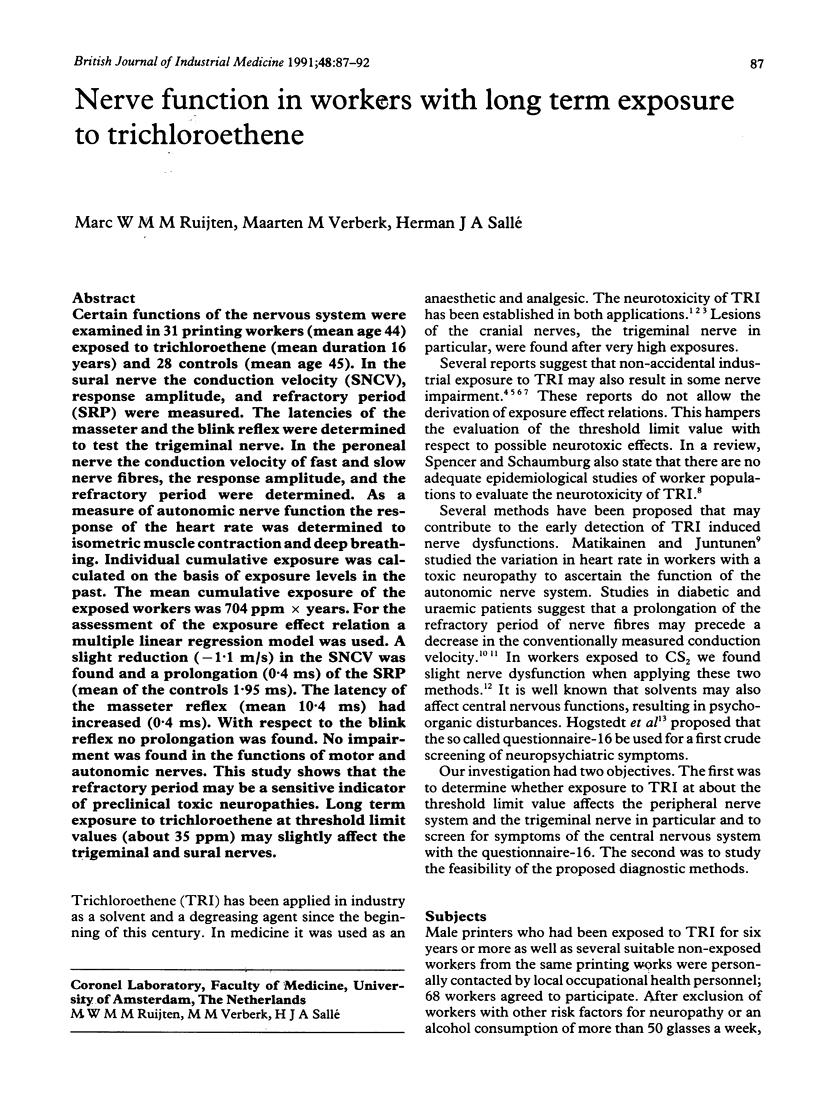
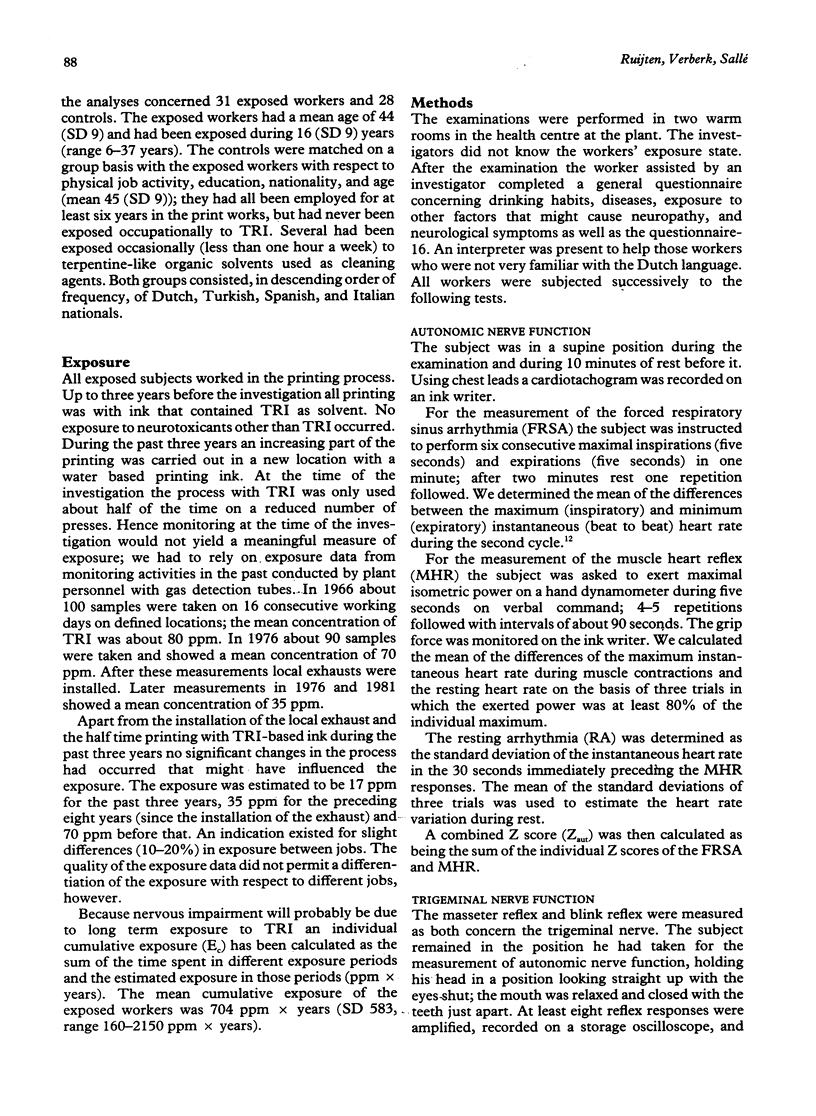
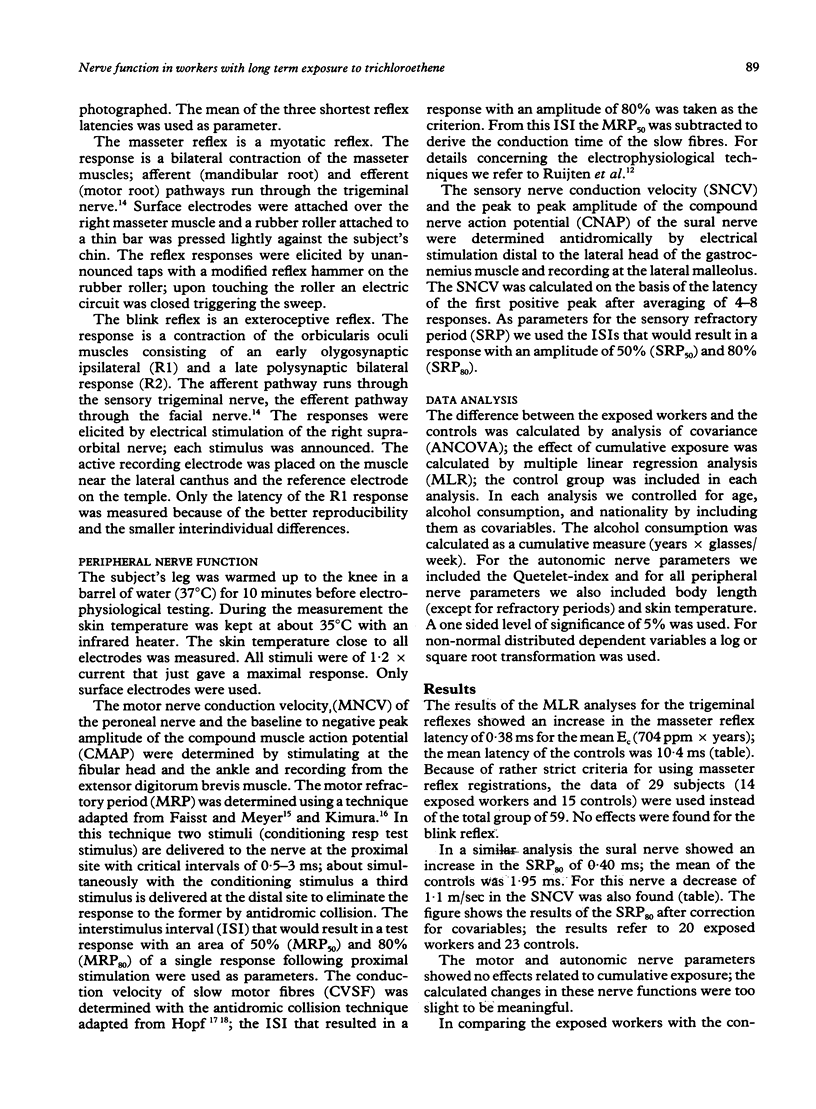
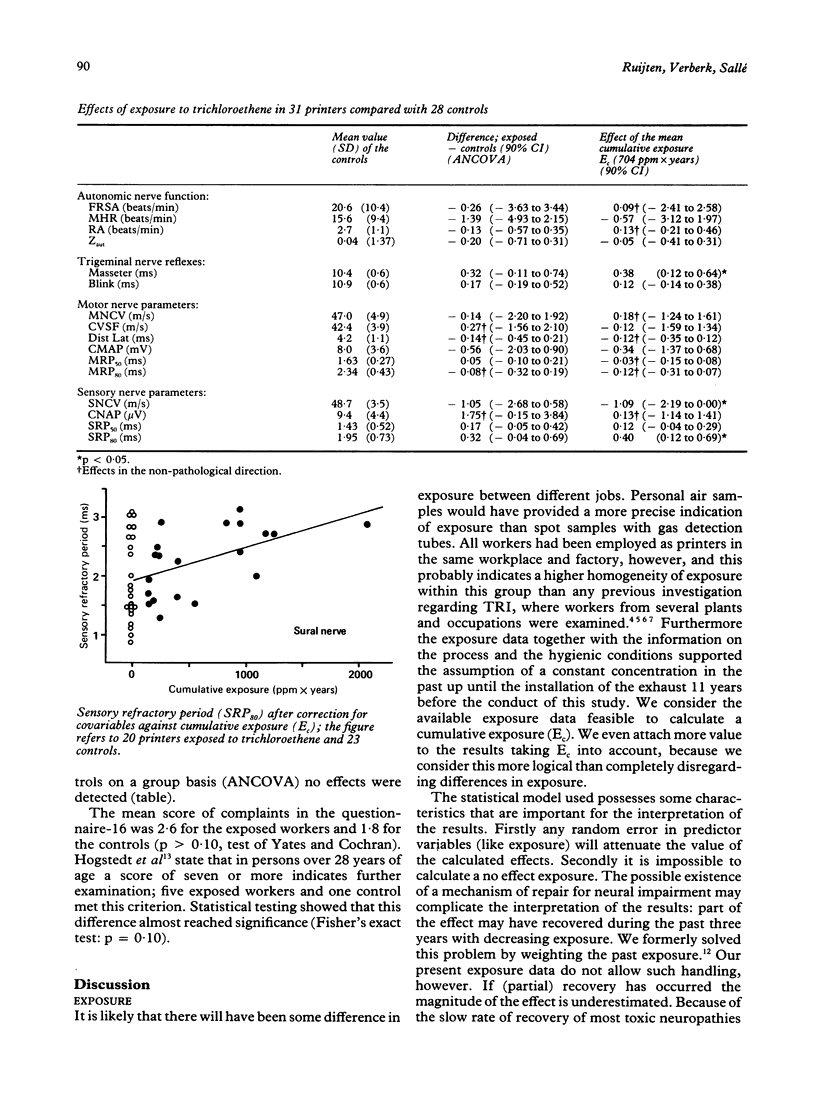
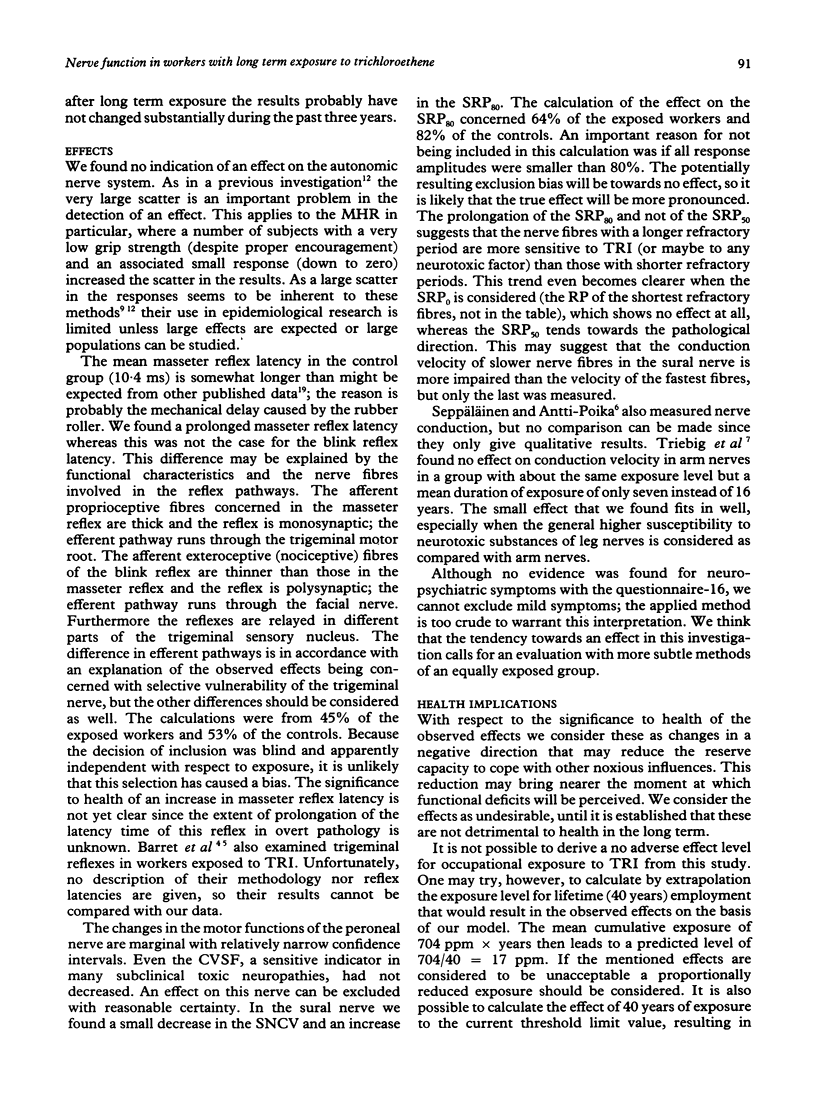
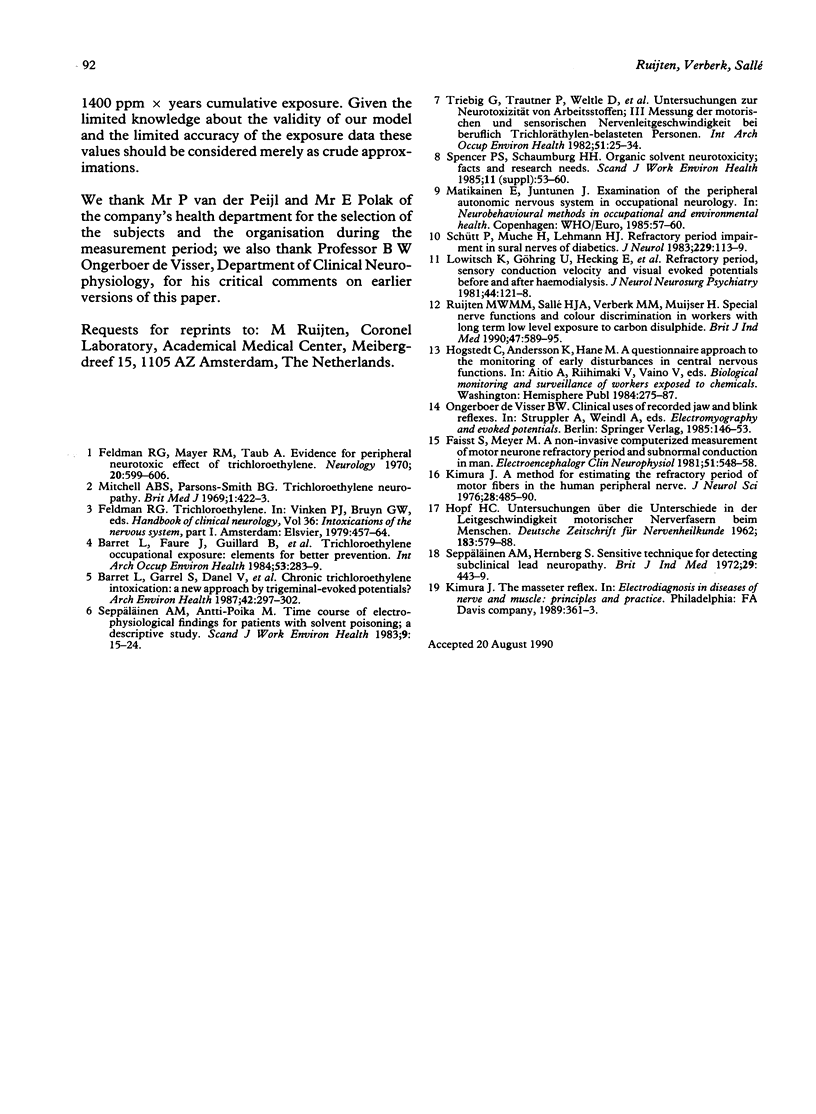
Selected References
These references are in PubMed. This may not be the complete list of references from this article.
- Barret L., Faure J., Guilland B., Chomat D., Didier B., Debru J. L. Trichloroethylene occupational exposure: elements for better prevention. Int Arch Occup Environ Health. 1984;53(4):283–289. doi: 10.1007/BF00380666. [DOI] [PubMed] [Google Scholar]
- Barret L., Garrel S., Danel V., Debru J. L. Chronic trichloroethylene intoxication: a new approach by trigeminal-evoked potentials? Arch Environ Health. 1987 Sep-Oct;42(5):297–302. doi: 10.1080/00039896.1987.9935824. [DOI] [PubMed] [Google Scholar]
- Faisst S., Meyer M. A non-invasive computerized measurement of motor neurone refractory period and subnormal conduction in man. Electroencephalogr Clin Neurophysiol. 1981 May;51(5):548–558. doi: 10.1016/0013-4694(81)90231-5. [DOI] [PubMed] [Google Scholar]
- Feldman R. G., Mayer R. M., Taub A. Evidence for peripheral neurotoxic effect of trichloroethylene. Neurology. 1970 Jun;20(6):599–606. doi: 10.1212/wnl.20.6.599. [DOI] [PubMed] [Google Scholar]
- Kimura J. A method for estimating the refractory period of motor fibers in the human peripheral nerve. J Neurol Sci. 1976 Aug;28(4):485–490. doi: 10.1016/0022-510x(76)90119-2. [DOI] [PubMed] [Google Scholar]
- Lowitzsch K., Göhring U., Hecking E., Köhler H. Refractory period, sensory conduction velocity and visual evoked potentials before and after haemodialysis. J Neurol Neurosurg Psychiatry. 1981 Feb;44(2):121–128. doi: 10.1136/jnnp.44.2.121. [DOI] [PMC free article] [PubMed] [Google Scholar]
- Mitchell A. B., Parsons-Smith B. G. Trichloroethylene neuropathy. Br Med J. 1969 Feb 15;1(5641):422–423. doi: 10.1136/bmj.1.5641.422. [DOI] [PMC free article] [PubMed] [Google Scholar]
- Ruijten M. W., Sallé H. J., Verberk M. M., Muijser H. Special nerve functions and colour discrimination in workers with long term low level exposure to carbon disulphide. Br J Ind Med. 1990 Sep;47(9):589–595. doi: 10.1136/oem.47.9.589. [DOI] [PMC free article] [PubMed] [Google Scholar]
- Schütt P., Muche H., Lehmann H. J. Refractory period impairment in sural nerves of diabetics. J Neurol. 1983;229(2):113–119. doi: 10.1007/BF00313450. [DOI] [PubMed] [Google Scholar]
- Seppäläinen A. M., Antti-Poika M. Time course of electrophysiological findings for patients with solvent poisoning. A descriptive study. Scand J Work Environ Health. 1983 Feb;9(1):15–24. doi: 10.5271/sjweh.2447. [DOI] [PubMed] [Google Scholar]
- Seppäläinen A. M., Hernberg S. Sensitive technique for detecting subclinical lead neuropathy. Br J Ind Med. 1972 Oct;29(4):443–449. doi: 10.1136/oem.29.4.443. [DOI] [PMC free article] [PubMed] [Google Scholar]
- Spencer P. S., Schaumburg H. H. Organic solvent neurotoxicity. Facts and research needs. Scand J Work Environ Health. 1985;11 (Suppl 1):53–60. [PubMed] [Google Scholar]
- Triebig G., Trautner P., Weltle D., Saure E., Valentin H. Untersuchungen zur Neurotoxizität von Arbeitsstoffen. III. Messung der motorischen und sensorischen Nervenleitgeschwindigkeit bei beruflich Trichloräthylen-belasteten Personen. Int Arch Occup Environ Health. 1982;51(1):25–34. doi: 10.1007/BF00378407. [DOI] [PubMed] [Google Scholar]


